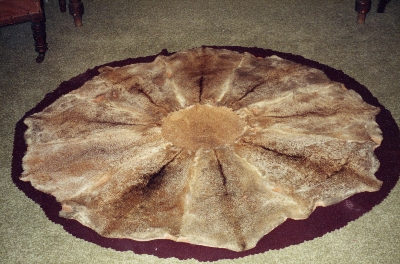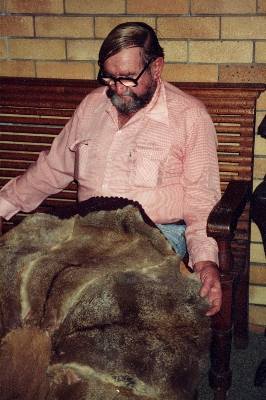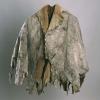Quilt No.120BF - Bud and Patricia Ford

Owner:
Bud and Patricia Ford
Location:
QLD South West
Maker
Maker:
Unknown
Made in
AUSTRALIA QLD
Patterms
Date:
1921 - 1940
Description:
Round rug of whip tail wallaby skins pieced into centre circle. Skins have been joined and then stitched on to maroon baize backing which has traditional punched scalloped edge. The skins are wattle bark tanned.
Diameter 1449mm
History:
The wallabies were snared (not shot) by a Mr. Kynock's son in the scrub near Ravensborne Queensland. They were wattle bark tanned at the Cloake Tannery in Toowoomba. The rug was constructed by Hugh Bird Ford, father of the present owner, in the 1930s. The rug is not used now but is in the music room of Bud and Patricia Ford's home over the back of a chair.
Story:
Mr. Kynock's son who snared the whip tail wallabies was paid 2/6 each for them. After they were wattle bark tanned at Cloake's tannery in Toowoomba, Hugh Bird Ford [1895-1968] used a template of 3 ply to get them all the same size.
Bud Ford, present owner and son of the maker, recalled that the rug was always on his parents large double bed and that his father was very proud of it.

Bud Ford with the whip tail wallaby rug
Related Quilts:
Kangaroo skin cloak of seven gores is made from the skins of seven grey kangaroos (Macropus fuliginosus). The skins vary in size and shape, the inner five are roughly triangular. The cloak is edged with a series of loops, through one of these near the collar is a piece of cloth which appears to have tied the cloak together. The skins are sewn together with two sorts of linen or cotton thread. In a small diamond-shaped gusset at the back of the neck there are some stitches of sinew. The skins are sewn together by means of a small hem which was turned back on to the fur, so stitches went through two layers of skin on each gore. There are some small holes in the skins. The skins are very soft and pliable, and greyish in colour; they vary in size and shape.
Longest part: 800mm
Ref: MA Thesis 1973, S.Meagher 'A Reconstruction of the Traditional Life of the Aborigines of the S.W. of Western Australia.
Rug made from skins of black quolls. The skins are dark grey-brown with black areas and each skin has cream spots. The skins are mainly machine stitched together with a few roughly hand sewn. The backing is maroon felt and this extends beyond the top with a scalloped edging. There is yellow ric-rac braid hand sewn on the back seam.
1300 x 885mm
Fox skin rug of exceptionally fine skins with brushes incorporated into the design. It is backed with brown felt with traditional stamped scalloped edge. 1800 x 1500mm
Rug made from 12 large kangaroo skins. There are 4 'reds' ,one in each corner and the rest are 'greys'. The backing is green felt with the traditional scalloped edge extending beyond the fur. There is also black rat tail braid outlining the actual rug on the backing.
1850 x 1520mm
Dingo skin rug. 3 skins long x 5 skins wide with only the backs of the skins used. The backing is blue felt. The skins were tanned with wattle bark.
2100 x 1800mm
Rug made from 40 brown fur skins (8 rows by 5), possibly possum. Skins are sewn by machine, with seams covered with white tape. Rug is backed with cream wool felt, and bordered with beige scalloped felt. There is a braid binding along the outer edge of the skins. No padding.
1640 x 1480mm






